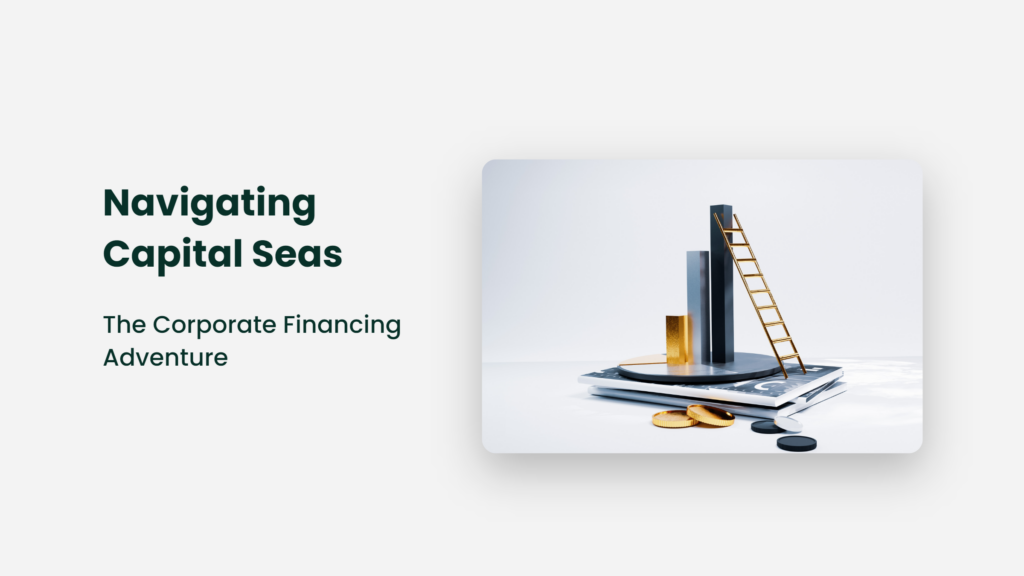“Money is only a tool. It will take you wherever you wish, but it will not replace you as the driver.” – Ayn Rand.
Picture yourself as the captain of a majestic ship sailing through the vast and untamed ocean of corporate finance. With a solid and steady hand on the wheel, you navigate the swirling currents of investment, loans, and equity, all while keeping your eyes on the horizon, searching for your company’s next ample opportunity. Let’s embark on this thrilling adventure together and discover the financial seas’ strategies, pitfalls, and rewards.
Chapter One: Setting Sail – The Basics of Corporate Financing

As the adage goes, “Money makes the world go round,” but where does it come from, and how do companies obtain it? Corporate financing is how companies secure the capital to fund their operations, growth, and investments. Capital budgeting can come in two primary forms: debt and equity.
Debt financing involves borrowing money from investment banks, financial institutions, or bond markets, which must be repaid with interest over time.
On the other hand, equity financing involves selling ownership stakes in the company, such as stocks or shares, in exchange for capital investment. Each financing type has pros and cons, and the savvy captain must decide which course to chart.
Chapter Two: The Captain’s Dilemma – Equity vs. Debt Financing

As we continue our journey, the waters of corporate financing grow increasingly turbulent. The captain faces a crucial decision: hoist the equity sails or drop anchor with debt. Which will propel the company towards growth, and which might sink it to insolvency?
The decision to choose debt or equity financing is not taken lightly. Equity financing allows a company to raise money without increasing its debt burden while avoiding the need to make regular interest payments. However, it comes at the cost of diluting ownership and potentially relinquishing some control over the business.
Debt financing can be a more attractive option for companies seeking to maintain control and correct. Still, it comes with the responsibility of repaying loans and interest, which can strain cash flows and lead to financial distress if not managed carefully.
So, what’s a captain to do? Consider the following hypothetical scenario:
*The good ship “Innovate Inc.” is sailing towards the promising shores of expansion. The company needs to raise $5 million to fund this exciting voyage. They could issue 1 million shares at $5 per share, diluting their ownership and potentially surrendering some control to new investors. Alternatively, they could secure a loan with a 7% interest rate, requiring them to make annual interest payments of $350,000. Which course should the captain choose?
As with any significant decision, the answer depends on the company’s unique circumstances, risk tolerance, and long-term goals. No solution fits all situations, and the wisest captains know when to adjust their course to changing winds and currents.
Chapter Three: Navigating the Waters – Creative Financing Strategies

As our voyage through corporate financing continues, we come across many creative strategies that resourceful captains have employed to keep their ships afloat. Here are a few examples of innovative financing solutions that have made waves in the world of business:
- Crowdfunding: Companies like Kickstarter and Indiegogo have revolutionized how businesses raise capital by allowing them to tap into the power of the crowd. By offering exclusive perks or rewards, companies can entice individuals to invest in their ventures, raising small amounts of money from many people.
- Convertible Bonds: A hybrid of debt and equity, convertible bonds allow investors to convert their bonds into a predetermined number of shares at a specified time. This will enable companies to raise capital while offering investors the potential upside of owning stock.
- Mezzanine Financing: This form of financing sits between debt and equity, offering lenders the security of debt while providing the potential for equity-like returns. Mezzanine financing can be an attractive option for growing companies that require funding but wish to avoid the dilution of issuing new shares.
Chapter Four: The Captain’s Log – Lessons from the High Seas of Corporate Financing
As we journey through the world of corporate financing, it’s essential to learn from the experiences of those who have navigated these treacherous waters before us. Here are a few nuggets of wisdom from the captains who have successfully charted their course:
“The only way you are going to succeed is to have lots of failures first.” – Sergey Brin, co-founder of Google.
Failure can be an influential teacher, and it is crucial to learn from setbacks and mistakes to refine your strategies and adapt to the ever-changing currents of corporate financing.
“Stay self-funded as long as possible.” – Garrett Camp, co-founder of Uber
Maintaining control and ownership of your company can be a powerful motivator and allow you to focus on long-term growth rather than short-term profits. While external financing can be necessary for expansion, carefully weighing costs and benefits is essential.
Chapter Five: Charting Your Course – A Quiz to Test Your Knowledge
Ahoy, matey! Are you ready to set sail on your corporate financing adventure? Test your knowledge with this brief quiz:
- What are the two primary forms of corporate financing?
- What are the pros and cons of debt financing?
- What are the pros and cons of equity financing?
- Name three creative financing strategies.
- What are some lessons we can learn from successful captains of industry?
Frequently Asked Questions
Q: How do I determine the best financing option for my company?
A: The right financing option depends on your company’s unique circumstances, goals, and risk tolerance. It’s essential to weigh the pros and cons of debt and equity financing and consider alternative financing strategies to determine the best course for your company.
Q: Is it possible to combine different forms of financing?
A: Absolutely! Many companies employ a blend of debt, equity, and alternative financing strategies to meet their capital financing needs while minimizing risk and maintaining control.
Q: When should I seek external financing for my business?
A: The decision to seek external financing depends on several factors, including your company’s growth stage, cash flow, and long-term goals. External funding may be necessary if your business is experiencing rapid growth and requires additional capital to seize new opportunities. However, it’s essential to carefully weigh the costs and benefits of each financing option and consider the impact on your company’s capital structure and financial stability.
Q: How can I improve my chances of securing financing?
A: To improve your chances of securing financing, focus on building a solid business plan, demonstrating a track record of success, maintaining strong financial management, and cultivating relationships with potential investors or lenders. A strong business plan, backed by data and a clear vision, can be a powerful tool in convincing others to invest in your company’s future.
Anchors Aweigh: Sailing Towards Success in Corporate Financing
As we bring our voyage through the world of corporate financing to a close, it’s essential to remember that the journey is just as important as the destination. By understanding the basics of debt and equity financing, exploring creative strategies, and learning from the experiences of others, you can confidently navigate the financial seas and steer your company towards success.
As we part ways, remember the words of Sir Richard Branson, founder of the Virgin Group, who once said, “Do not be embarrassed by your failures; learn from them and start again.” May these words serve as a guiding star on your journey through the turbulent waters of corporate financing, and may the wind be ever at your back.
Happy sailing, dear captain!




